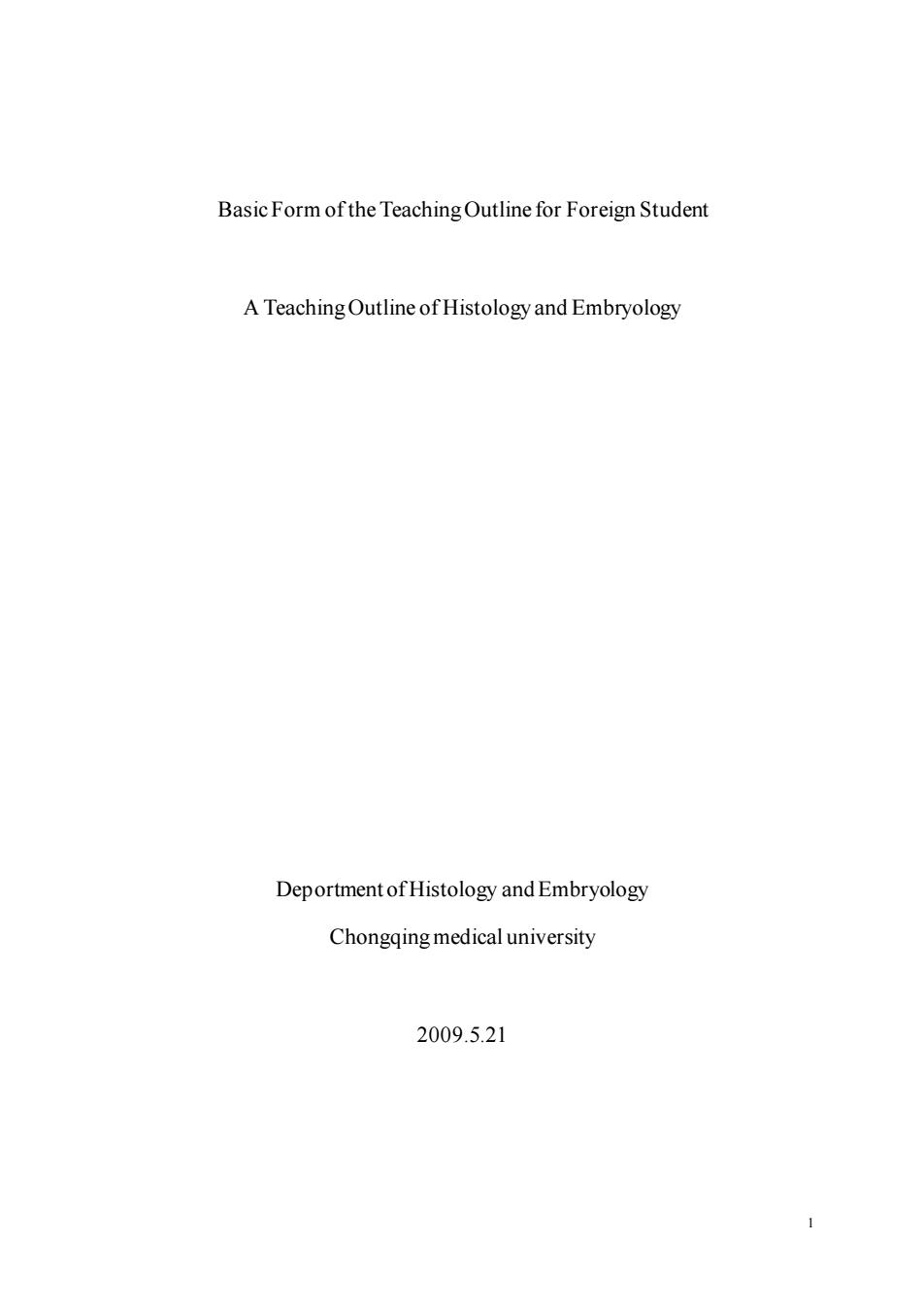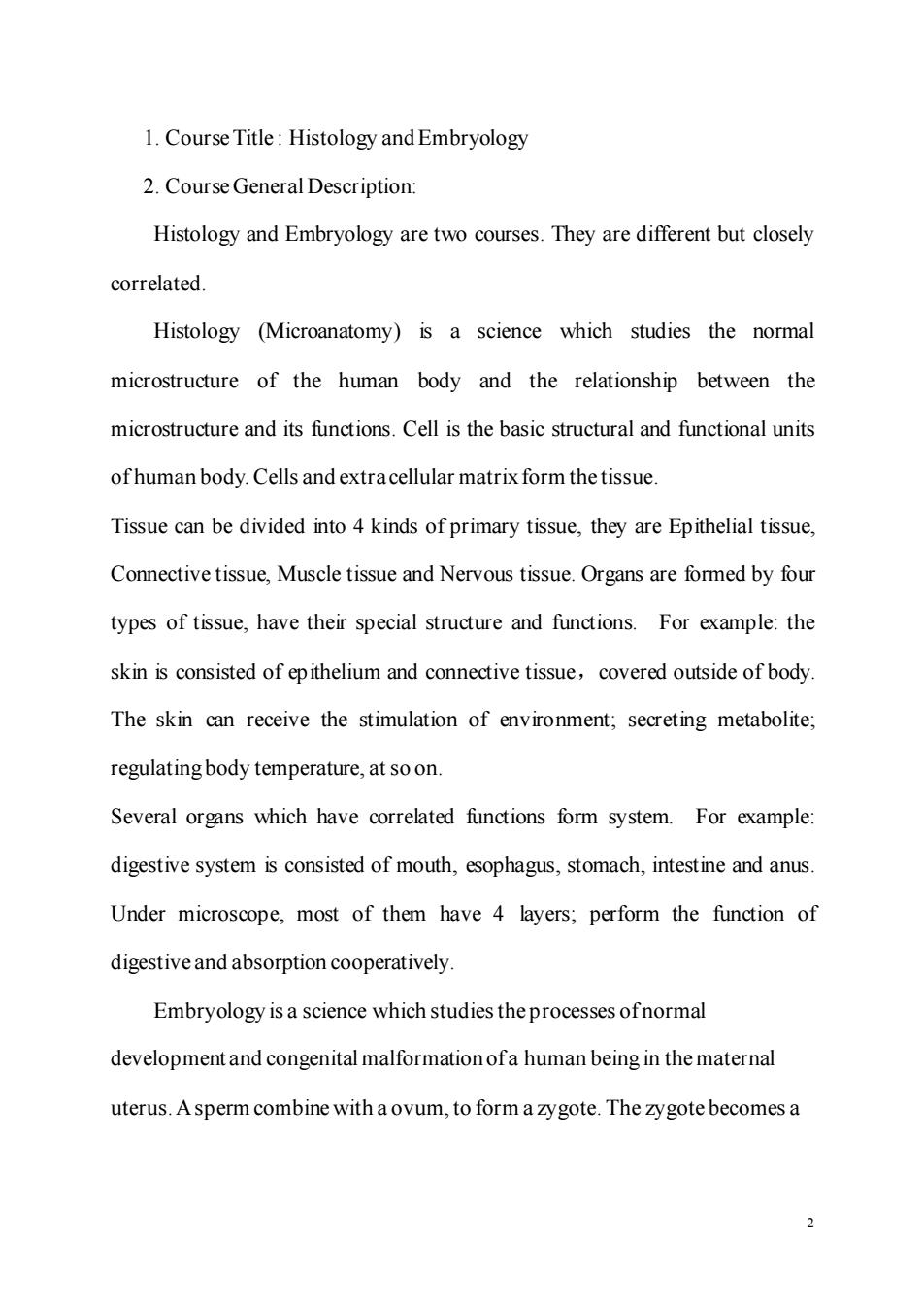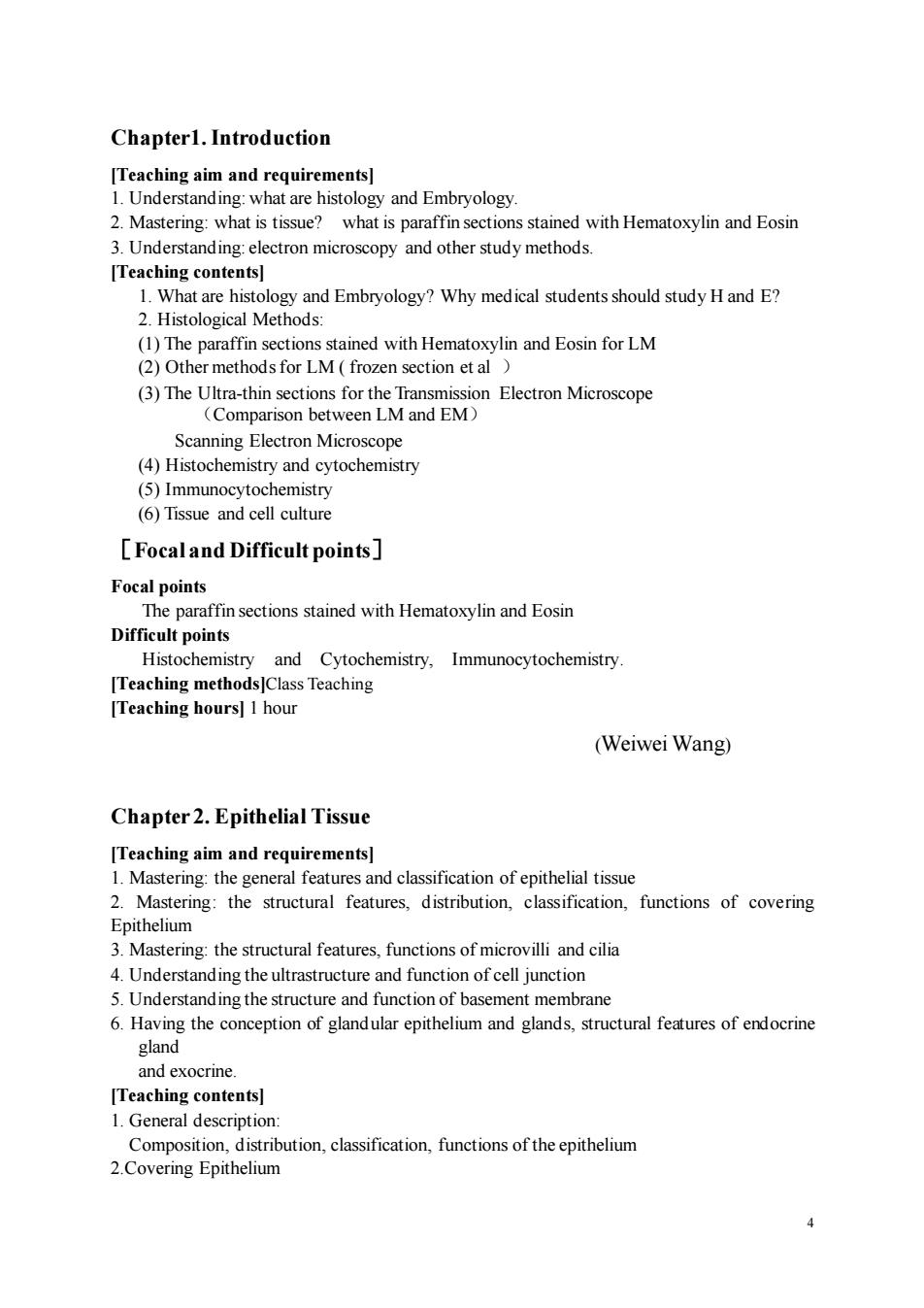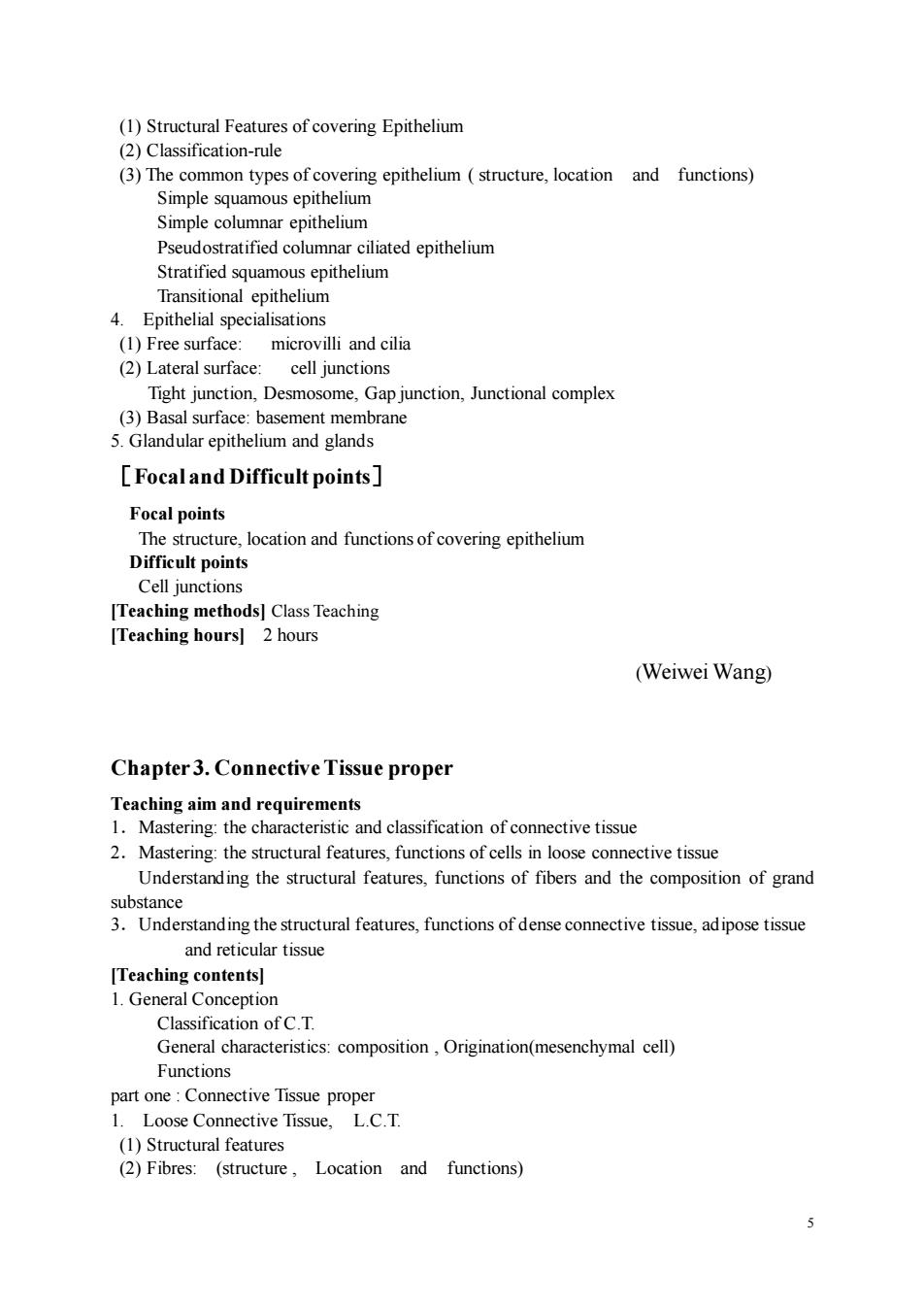
Basic Form of the Teaching Outline for Foreign Student A Teaching Outline of Histology and Embryology Deportment of Histology and Embryology Chongqing medical university 2009.5.21
1 Basic Form of the Teaching Outline for Foreign Student A Teaching Outline of Histology and Embryology Deportment of Histology and Embryology Chongqing medical university 2009.5.21

1.Course Title:Histology and Embryology 2.Course General Description: Histology and Embryology are two courses.They are different but closely correlated Histology (Microanatomy)is a science which studies the normal microstructure of the human body and the relationship between the microstructure and its functions.Cell is the basic structural and functional units ofhuman body.Cells and extracellular matrix form the tissue. Tissue can be divided into 4 kinds of primary tissue,they are Epithelial tissue, Connective tissue,Muscle tissue and Nervous tissue.Organs are formed by four types of tissue,have their special structure and functions.For example:the skin is consisted of epithelium and connective tissue,covered outside of body. The skin can receive the stimulation of environment;secreting metabolite: regulating body temperature,at so on. Several organs which have correlated functions form system.For example digestive system is consisted of mouth,esophagus,stomach,intestine and anus. Under microscope,most of them have 4 layers;perform the function of digestive and absorption cooperatively. Embryology is a science which studies the processes ofnormal development and congenital malformation ofa human being in the maternal uterus.A sperm combine with a ovum,to form a zygote.The zygote becomes a 2
2 1. Course Title : Histology and Embryology 2. Course General Description: Histology and Embryology are two courses. They are different but closely correlated. Histology (Microanatomy) is a science which studies the normal microstructure of the human body and the relationship between the microstructure and its functions. Cell is the basic structural and functional units of human body. Cells and extra cellular matrix form the tissue. Tissue can be divided into 4 kinds of primary tissue, they are Epithelial tissue, Connective tissue, Muscle tissue and Nervous tissue. Organs are formed by four types of tissue, have their special structure and functions. For example: the skin is consisted of epithelium and connective tissue,covered outside of body. The skin can receive the stimulation of environment; secreting metabolite; regulating body temperature, at so on. Several organs which have correlated functions form system. For example: digestive system is consisted of mouth, esophagus, stomach, intestine and anus. Under microscope, most of them have 4 layers; perform the function of digestive and absorption cooperatively. Embryology is a science which studies the processes of normal development and congenital malformation of a human being in the maternal uterus. Asperm combine with a ovum, to form a zygote. The zygote becomes a

fetus after 56days offertilization,and then growth,to be childbirth at the 266th day. 3.Contents ofMajor Chapters and Sectionsofthe Course Chapter Content Total time theory teching h.experiment h. Introduction 7 2 2 Epithelial tisse 2 34 Connective tissue 14 2 Cartilage and Bone 2 Blood and Haemopoiesis 2 35 6 Muscular tissue 1 2 1 15 1.5 2 10 Lymphatic organs 2 14 Skin 1 11 Digestive tract 7 3 4 12 egland Kespiratory system 15 Urinary system 7 2 22 17 Male reproductive system 18 Female reproductivesystem > 2 4 Ferrtilization 19 Embryo development 6 3 of earlier period 3 19 Fetal membrane,placenta 6 3 and congenital malformation Total Hours 81 36 (Weiwei Wang)
3 fetus after 56days of fertilization, and then growth, to be childbirth at the 266th day. 3. Contents of Major Chapters and Sections of the Course Chapter Content Total time theory teching h. experiment h. 1 Introduction 7 1 2 2 Epithelial tissue 2 2 3 Connective tissue 14 2 3 4 Cartilage and Bone 2 2.5 5 Blood and Haemopoiesis 2 2.5 6 Muscular tissue 7 1 2 7 Nervous tissue 2 2 8 Circulatory system 7 1.5 2 9 Endocrine system 1.5 2 10 Lymphatic organs 7 2 3 14 Skin 1 1 11 Digestive tract 7 3 4 12 Digestive gland 7 1.5 2 13 Respiratory system 1.5 2 15 Urinary system 7 2 2 17 Male reproductive system 1 2 18 Female reproductive system 7 2 4 Ferrtilization 1 19 Embryo development 6 3 3 of earlier period 3 3 19 Fetal membrane,placenta 6 3 3 and congenital malformation Total Hours 81 36 45 (Weiwei Wang)

Chapter1.Introduction [Teaching aim and requirements] 1.Understanding:what are histology and Embryology. 2.Mastering:what is tissue?what is paraffin sections stained with Hematoxylin and Eosin 3.Understanding:electron microscopy and other study methods. [Teaching conte What are ogy and Embryology?Why medical students should study Hand E? 2.Histological Methods: (1)The paraffin sections stained with Hematoxylin and Eosin for LM (2)Other methods for LM(frozen section et al (3)The Ultra-thin sections for the Transmission Electron Microscope (Comparison between LM and EM) Scanning Electron Microscope (4)Histochemistry and cytochemistry (5)Immunocytochemistry (6)Tissue and cell culture Focaland Difficult points] Focal points The paraffin sections stained with Hematoxylin and Eosin Difficult points Histochemistrv and Cytochemistry. Immunocytochemistry Teaching methods Cass Teaching [Teaching hours]1 hour (Weiwei Wang) Chapter 2.Epithelial Tissue [Teaching aim and requirements] 1.Mastering:the general features and classification of epithelial tissue 2.Mastering:the structural features,distribution,classification,functions of covering Epithelium Mastering:the structural features,functions of microvilli and cilia 4.Understanding the ultrastructure and function ofcell junction 5.Understanding the structure and function of basement membrane 6.Having the conception of glandular epithelium and glands,structural features of endocrine gland and exocrine [Teaching contents] 1.General description Composition,distribution,classification,functions of the epithelium 2.Covering Epithelium
4 Chapter1. Introduction [Teaching aim and requirements] 1. Understanding: what are histology and Embryology. 2. Mastering: what is tissue? what is paraffin sections stained with Hematoxylin and Eosin 3. Understanding: electron microscopy and other study methods. [Teaching contents] 1. What are histology and Embryology? Why medical students should study H and E? 2. Histological Methods: (1) The paraffin sections stained with Hematoxylin and Eosin for LM (2) Other methods for LM ( frozen section et al ) (3) The Ultra-thin sections for the Transmission Electron Microscope (Comparison between LM and EM) Scanning Electron Microscope (4) Histochemistry and cytochemistry (5) Immunocytochemistry (6) Tissue and cell culture [Focal and Difficult points] Focal points The paraffin sections stained with Hematoxylin and Eosin Difficult points Histochemistry and Cytochemistry, Immunocytochemistry. [Teaching methods]Class Teaching [Teaching hours] 1 hour (Weiwei Wang) Chapter 2. Epithelial Tissue [Teaching aim and requirements] 1. Mastering: the general features and classification of epithelial tissue 2. Mastering: the structural features, distribution, classification, functions of covering Epithelium 3. Mastering: the structural features, functions of microvilli and cilia 4. Understanding the ultrastructure and function of cell junction 5. Understanding the structure and function of basement membrane 6. Having the conception of glandular epithelium and glands, structural features of endocrine gland and exocrine. [Teaching contents] 1. General description: Composition, distribution, classification, functions of the epithelium 2.Covering Epithelium

(1)Structural Features of covering Epithelium (2)Classification-rule (3)The common types of covering epithelium (structure,location and functions) Simple squamous epithelium Simple columnar epithelium Pseudostratified columnar ciliated epithelium ous epithelium Transitional epithelium 4.Epithelial specialisations (1)Free surface:microvilli and cilia (2)Lateral surface: cell junctions Tight junction,Desmosome.Gap junction,Junctional complex (3)B surface basement membrane 5.Glandular epithelium and glands Focal and Difficult points] Focal points Cell junctions [Teaching methods]Class Teaching [Teaching hours]2 hours (Weiwei Wang) Chapter3.Connective Tissue proper Teaching aim and requirements 1.Mastering:the characteristic and classification of connective tissue 2.Mastering:the structural features.functions of cells in loose connective tissue Understanding the structural features.functions of fibers and the composition of grand substance 3.Understanding the structural features,functions of dense connective tissue,adipose tissue and reticula r tissue [Teaching contents] 1 General Concention Classification of c T General characteristics:composition,Origination(mesenchymal cell) Functions part one:Connective Tissue proper 1.Loose Connective Tissue,L.C.T. (1)Structural features (2)Fibres:(structure, Location and functions)
5 (1) Structural Features of covering Epithelium (2) Classification-rule (3) The common types of covering epithelium ( structure, location and functions) Simple squamous epithelium Simple columnar epithelium Pseudostratified columnar ciliated epithelium Stratified squamous epithelium Transitional epithelium 4. Epithelial specialisations (1) Free surface: microvilli and cilia (2) Lateral surface: cell junctions Tight junction, Desmosome, Gap junction, Junctional complex (3) Basal surface: basement membrane 5. Glandular epithelium and glands [Focal and Difficult points] Focal points The structure, location and functions of covering epithelium Difficult points Cell junctions [Teaching methods] Class Teaching [Teaching hours] 2 hours (Weiwei Wang) Chapter 3. Connective Tissue proper Teaching aim and requirements 1.Mastering: the characteristic and classification of connective tissue 2.Mastering: the structural features, functions of cells in loose connective tissue Understanding the structural features, functions of fibers and the composition of grand substance 3.Understanding the structural features, functions of dense connective tissue, adipose tissue and reticular tissue [Teaching contents] 1. General Conception Classification of C.T. General characteristics: composition , Origination(mesenchymal cell) Functions part one : Connective Tissue proper 1. Loose Connective Tissue, L.C.T. (1) Structural features (2) Fibres: (structure , Location and functions)